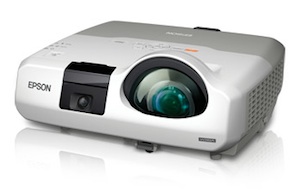Epson To Ship Portable, Interactive Short-Throw Projector This Month

The Epson BrightLink 436Wi |
This month Epson will roll out a new model in its BrightLink line of interactive projectors. The new LCD-based BrightLink 436Wi will be the first portable unit in the lineup, weighing less than 10 pounds.
The BrightLink 436Wi, introduced at the FETC 2013 conference in Orlando, FL last week, offers a resolution of 1,280 x 800 (WXGA), a brightness of 3,000 lumens, and a contrast ratio of 3,000:1. Like other models in the BrightLink series, the 436Wi provides interactive capabilities (similar to an interactive whiteboard) without the need for a computer. Teachers and students project images from tablets, mobile phones, document cameras, or traditional computers and annotate on images using multiple interactive pens.
The new model supports networking via wired RJ-45. It also includes an 802.11b/g/n port for optional wireless capabilities.
The BrightLink 436Wi is also a short-throw projector, providing a throw ratio of 0.48 to 0.65 for projecting images 53 inches to 116 inches (diagonal) or 68 inches to 113 inches when mounted on the optional wall mount.
Other features include:
- Dual pen support;
- PC-free annotations;
- Ability to display content over an IP network;
- Keystone correction ±7 degrees vertical or ±5 degrees horizontal;
- Built-in 10 watt speaker;
- Up to 6,000-hour lamp life; and
- Software compatible with Mac and Windows systems.
AV inputs include HDMI, dual RGB (mini D-sub 15-pin), USB type B for display and audio, S-video, composite video, stereo RCA jacks, dual stereo minijacks, and a stereo microphone jack. Outputs include RGB and stereo minijack. Networking ports include wired LAN (RJ-45), USB type A, and RS-232C.
Excluding feet, the 436Wi measures 13.6" (w) x 10.9" (d) x 4.1" (h) and weighs in at 9.1 pounds.
The BrightLink 436Wi is expected to ship later this month. Pricing has not yet been announced. Additional details about the BrightLink 436Wi can be found on Epson's site.